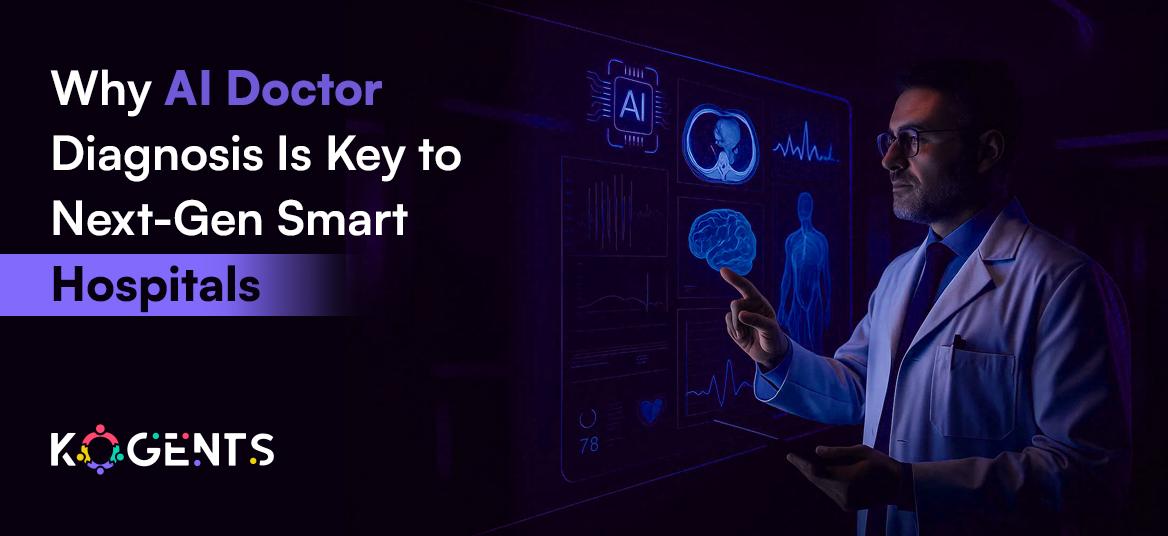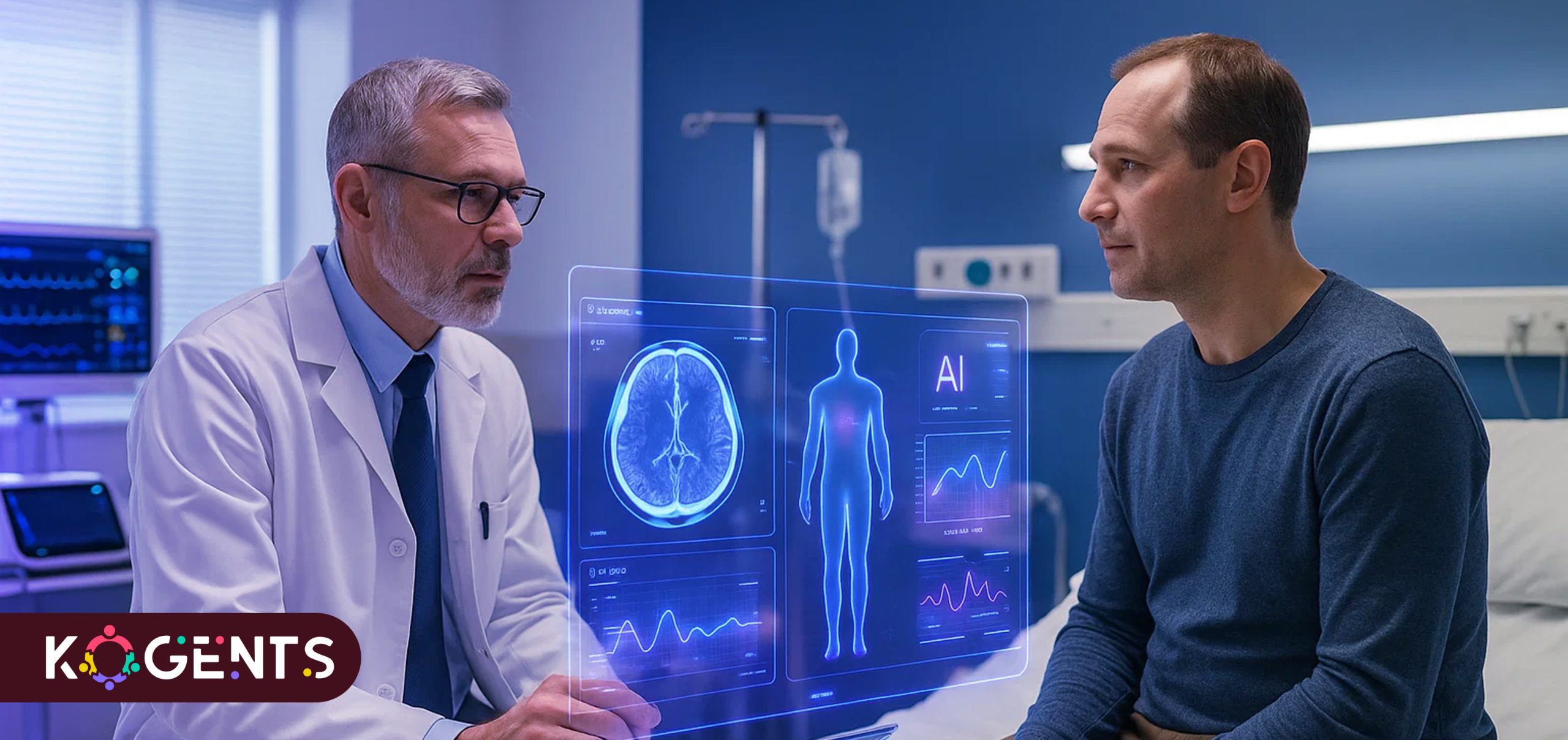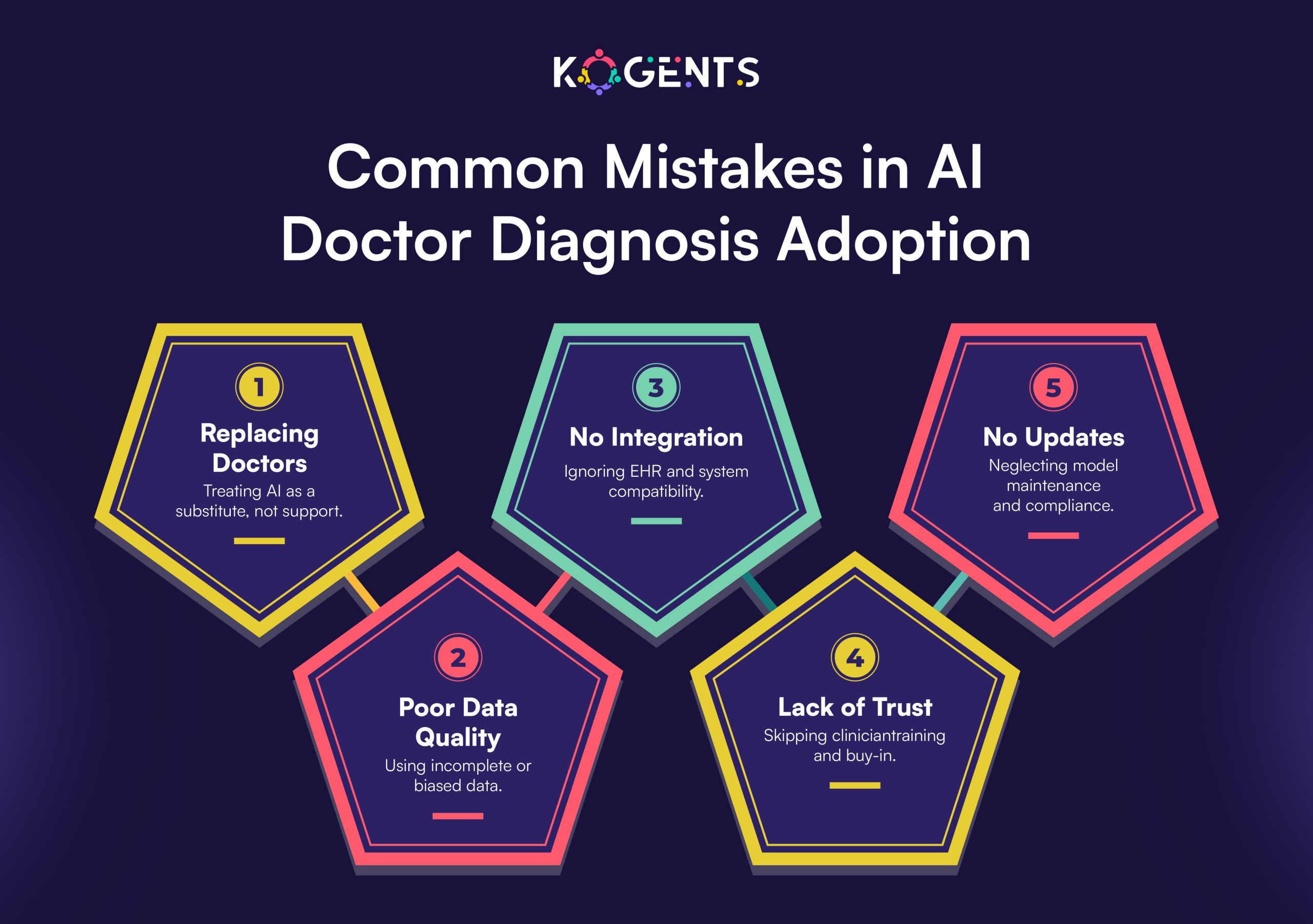Why AI Doctor Diagnosis Is Key to Next-Gen Smart Hospitals

Summary:
In a world of soaring patient volumes, chronic staffing shortages, aging populations, and relentless healthcare costs, the future of medicine demands smarter infrastructure.
Today, where time is oxygen and errors are costly, AI doctor diagnosis platforms are more than technology; it’s the line between early detection and missed diagnosis, between saving a life and suffering a preventable complication.
An AI Doctor Diagnosis platform is built for the next era of care, which is more than just clinical software, but a platform that is an intelligent agent that blends artificial intelligence in medical diagnosis, AI-assisted clinical diagnosis, and real-time AI symptom checker capabilities into one seamless system. As hospitals transform into sensor-rich, intelligent environments, healthcare AI diagnostic systems emerge as critical nodes, agents that can ponder, reason, and act alongside medical teams in high-stakes situations.
The goal isn’t to replace doctors, but to extend them, equipping every clinician with a tireless second brain that processes data at lightning speed and never misses a beat.
Key Takeaways
- Understanding how AI doctor diagnosis platforms transform smart hospitals with faster and more accurate care.
- Learning how AI agents work alongside clinicians to detect risks early and improve patient outcomes.
- Exploring the core features that make AI diagnosis agents essential for modern healthcare systems.
- Recognizing the benefits of AI in reducing errors, saving time, and building patient trust.
- Discovering future trends where AI agents collaborate across hospital ecosystems for seamless care delivery.
What is an AI Doctor Diagnosis Agent?
It is a platform-specific healthcare AI agent designed to assist, augment, and, in some cases, automate the medical diagnostic process.
Unlike generic chatbots or static rule-based systems, these agents apply contextual reasoning, pattern recognition, and domain expertise to deliver real-time diagnostic suggestions and care recommendations tailored to individual patients.
Rooted in Agentic AI principles, the diagnosis agent operates with:
- Autonomy: It independently retrieves, analyzes, and synthesizes medical data without continuous human intervention.
- Proactivity: It doesn’t passively wait for commands. If it detects early signs of sepsis in a patient’s vitals or a potential stroke from imaging, it initiates a response.
- Goal-Orientation: Every action it takes is in pursuit of a defined clinical decision support system (CDSS): accurate diagnosis, timely treatment, and improved patient safety outcomes.AI-driven diagnosis agents empower smart hospitals with fast, more accurate care, reducing errors, easing workloads, and improving patient outcomes.
Key Highlight: These agents are capable of ingesting multi-source data, structured records like lab results and vital signs, and unstructured content such as physician notes or radiology AI reports, and processing it through clinical ontologies, NLP models, and predictive modelling algorithms to emulate the diagnostic reasoning of human doctors.
How an AI Doctor Diagnosis Agent Works?
The operational architecture of a diagnosis agent like MediSyn typically follows a four-step cognitive loop:
1. Input
It begins by gathering patient data from multiple sources:
- Electronic Health Records (EHRs)
- PACS (Picture Archiving and Communication Systems)
- Lab Information Systems (LIS)
- Wearable health devices (smartwatches, glucose monitors)
- IoT-enabled hospital devices (bedside monitors, infusion pumps)
2. Reasoning
Using natural language processing, computer vision, and diagnostic algorithms, the agent synthesizes this data to:
- Identify abnormal patterns or correlations
- Apply Bayesian reasoning or decision-tree logic
- Generate a ranked list of differential diagnoses
3. Action
Based on its findings, the agent:
- Suggests diagnoses and next steps
- Recommends additional tests or imaging
- Sends real-time alerts to physicians if critical thresholds are breached
4. Feedback
The agent learns from clinician responses:
- Was the diagnosis correct?
- Were the recommended tests useful?
- Was a condition overlooked?
This feedback is continuously integrated into its models, enhancing its diagnostic precision medicine AI over time.
Real-World Example:
A 58-year-old patient presents with shortness of breath and fatigue. MediSyn pulls their EHR, scans historical cardiology notes, and detects a history of atrial fibrillation. It notes elevated BNP and irregular EKG. Within seconds, it flags potential heart failure and suggests an echocardiogram.
The attending physician confirms the suspicion, and the agent logs this as a validated case for future model refinement.

Core Features of an AI Doctor Diagnosis Agent
1. Automation
- Auto-collects symptom descriptions via voice or text.
- Orders preliminary lab tests based on symptom clusters.
- Flags potential emergencies even before triage.
2. Personalization
- Adjusts diagnostic paths based on genetic markers or family history.
- Learns from prior visits, prescriptions, allergies, and comorbidities.
- Consider sociocultural factors (e.g., language, regional disease trends).
3. Multi-tasking
- Can manage hundreds of diagnostic processes in parallel.
- Works across departments: ER, radiology, cardiology, and infectious disease.
- Integrates asynchronously with remote devices and outpatient monitoring.
4. Reporting & Analytics
- Creates standardized clinical summaries for EMRs.
- Offers decision traceability (why a diagnosis was suggested).
- Provides population-level insights, flagging rising disease clusters or care gaps.
5. Clinical Pathway Navigation
- Guides physicians through gold-standard treatment protocols.
- Recommends evidence-based interventions based on diagnosis.
Use Cases for Individuals & Institutions
Doctors & Medical Entrepreneurs
- Solo practitioners use these diagnosis platforms for second opinions, especially in rare or complex cases.
- Telehealth providers integrate it into virtual consults to automate symptom triage.
- Concierge doctors streamline time-intensive diagnostics, allowing more face time with patients.
Hospitals & Clinics
- Emergency departments use the agent to prioritize critical cases.
- Outpatient clinics use it for follow-up care and chronic condition management.
- Rural hospitals benefit from built-in specialist-level expertise without needing in-house experts.
Care Teams and Coordinated Units
- Nurses receive proactive alerts about patient deterioration.
- Specialists can collaborate asynchronously through agent-curated case summaries.
- Case managers use the agent to plan discharges or identify readmission risks.
Benefits of Using an AI Diagnosis Agent
- Time Is Money
- AI diagnosis agents can process large amounts of patient data within seconds, drastically reducing wait times.
Pro-Tip! This allows clinicians to reach diagnostic conclusions faster, speeding up the entire care process.
- Enhances Accuracy
- By analyzing vast datasets and patterns, AI minimizes the chances of human oversight or missed details.
Know What Accuracy Can Do! A broader diagnostic accuracy range increases the likelihood of pinpointing the correct condition.
- Dominantly Better Outcomes
- Early and accurate diagnoses mean treatments can start sooner, improving patient recovery rates.
Grab The Long-Term Benefits: This proactive approach often results in better long-term health outcomes and reduced complications.
- Curbs Cognitive Load
- AI takes over repetitive and data-heavy tasks, freeing up doctors to focus on critical decision-making.
Shed Your Burden Off! This helps reduce fatigue and stress, improving clinician efficiency and patient care quality.
- 24/7 Real-time Support
- Unlike humans, AI systems are always available, offering diagnostic insights at any time of day.
It’s A Catch for You! Patients can receive timely support even during nights, weekends, or holidays.
- Improves Patient Trust
- AI provides transparent, evidence-based recommendations that patients can easily understand.
What Do You Get? It brings forth confidence, helping patients trust both the diagnosis and the medical team.
- Cost Efficiency
- By avoiding unnecessary tests and reducing repeat visits, AI cuts healthcare costs significantly.
Note: Hospitals and clinics save resources while patients benefit from more affordable care.
- Standardized Care
- AI ensures consistent diagnostic standards across different hospitals, clinics, and regions.
Impact: This reduces variation in care quality, giving patients reliable treatment no matter where they go.
Case in Point of Stanford: How It Leads in AI healthcare
Stanford leads AI in healthcare through AIMI, uniting 50+ faculty across 20 departments for medical machine-learning.
RAISE-Health drives equitable, ethical AI adoption in research and patient care.
Clinical tools include AI that gauges heart function in children, drafts patient notes, and enhances telehealth imaging. Imaging data is repurposed to detect hidden risks like coronary calcium for preventive care.
In glaucoma, AI predicts surgery needs better than specialists. Bias in screening models is addressed with combined human-AI methods for fairer outcomes.
Discovery accelerates via AI in cell morphology, protein evolution, and trial eligibility, translating science into impact.
Challenges and Limitations
Data Privacy & Compliance
- Must operate within HIPAA, GDPR, and other jurisdictional frameworks.
- Requires encryption, de-identification, and secure audit logs.
Interoperability Barriers
- Many hospitals still rely on siloed or legacy systems.
- Lack of standardized data formats can hinder input parsing.
Human Trust & Cultural Resistance
- Some clinicians are skeptical of non-human diagnosis.
- Trust must be earned through transparency and reliability.
Legal & Ethical Dilemmas
- Liability: Who is responsible if a patient is misdiagnosed?
- Bias: If training data is incomplete or biased, outputs may be skewed.
- Autonomy: Should an AI ever override a physician’s decision?
Model Maintenance
- Clinical guidelines evolve; agents must stay current.
- Continuous model training is essential to prevent performance decay.

AI Doctor Diagnosis Agent vs Other Agents
| Feature | AI Diagnosis Agent (MediSyn) | Slack Agent (Healthcare Bot) | WhatsApp Agent (Patient Chat) | Botim Agent (Remote Consults) |
| Domain Specialization | High (Medical Diagnosis) | Low | Low | Medium |
| EHR Integration | Full (via FHIR, HL7) | Minimal | None | Limited |
| Autonomy | High | Low | Low | Medium |
| Security & Compliance | HIPAA/GDPR-grade | Basic | Basic | Variable |
| Diagnostic Capabilities | Advanced | None | None | Limited |
| Data Handling | Structured & Unstructured | Structured | Unstructured | Unstructured |
| Feedback Loop for Learning | Yes | No | No | Partial |
| Real-Time Alerts | Yes | No | No | No |
| Clinical Workflow Support | Extensive | Minimal | None | Moderate |
The Future of AI Doctor Diagnosis Agents
Smarter Automation and Precision Diagnostics
- Incorporating genomic data, lifestyle metrics, and continuous glucose monitoring.
- AI models trained on global datasets, removing local biases and enhancing accuracy.
Integration into Multi-Agent Hospital Ecosystems
- Collaboration with nurse agents (for bedside tasks), pharmacist agents (for drug interaction alerts), and scheduling agents (for resource allocation).
- Coordinated actions across digital twins of hospitals.
Role in the Agentic AI Wave
- It becomes one of many specialized agents in a shared environment.
- Agents self-organize, refer patients to one another, and escalate care intelligently.
- AI systems gain the capacity for longitudinal memory, tracking health over the years.
Augmented Intelligence, Not Replacement
- Doctors become orchestrators of AI agents.
- Human intuition plus AI computation creates supercharged diagnostic performance.
Choose Us!
In a hospital where every minute counts and every datapoint matters, the AI Doctor Diagnosis Agent is more than a tool; it’s a strategic ally.
They are showing us how smart hospitals can operate with precision, speed, and safety.
It turns overwhelming data into actionable insights, supports clinicians in the trenches, and ultimately helps deliver better patient care.
The evolution of healthcare will not be provider vs. machine, but provider complemented with machine.
If you’re building or transforming a healthcare institution, now is the time to explore intelligent diagnostic agents.
Whether you’re trying to get a solution or planning full-scale integration, platforms like Kogents offer the foundational agent infrastructure to make it real.
So, explore the future of healthcare today. Visit Kogents AI today and drop an email at info@portal.kogents.ai or give us a call at (267) 248-9454 to gather more insights now.
FAQs
Can an AI diagnosis agent replace a human doctor?
No. AI diagnosis agents are designed to assist and augment human clinicians, not replace them. They handle data-intensive tasks, flag anomalies, and offer recommendations, but final decisions remain with medical professionals.
How accurate are these AI agents compared to doctors?
In many diagnostic scenarios, especially those involving large datasets (e.g., radiology, dermatology), AI agents can match or exceed human-level accuracy. However, they are most effective when used alongside clinicians who provide context and judgment.
Is patient data safe with AI diagnosis agents?
Yes, provided the system complies with regulations like HIPAA, GDPR, and employs encryption, access controls, and audit trails. Platforms like MediSyn prioritize data security and compliance.
What medical fields benefit most from AI diagnostic agents?
Emergency medicine, radiology, pathology, AI, cardiology, and primary care see significant gains. Anywhere large volumes of data must be interpreted quickly can benefit.
How hard is it to integrate an AI diagnosis agent into existing hospital systems?
Integration varies based on system maturity. Modern agents support FHIR, HL7, and DICOM standards, making them interoperable with most EHRs, PACS, and hospital management systems. Legacy systems may need middleware or APIs.
How does AI diagnose diseases?
AI uses machine learning algorithms trained on large medical datasets to analyze symptoms, lab results, and imaging scans, helping doctors identify possible conditions more quickly and accurately.
What are the best AI tools for medical diagnosis?
Some leading options include IBM Watson Health, Google DeepMind, and Ada Health, which provide AI-powered diagnostic support for hospitals, clinics, and patients.
Can I use AI to check symptoms online?
Yes, platforms like Ada Health AI app and other AI symptom checkers allow users to input symptoms and receive possible health insights, though they should not replace professional medical advice.

Kogents AI builds intelligent agents for healthcare, education, and enterprises, delivering secure, scalable solutions that streamline workflows and boost efficiency.